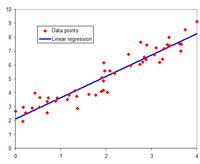
Photo from wikipedia
As the main indicator for assessing the explanatory strength of regression model, there is no denying that a bigger value of determination coefficient (R-squared, R2 ) is the consistent pursuit… Click to show full abstract
As the main indicator for assessing the explanatory strength of regression model, there is no denying that a bigger value of determination coefficient (R-squared, R2 ) is the consistent pursuit of researchers in human-environment field, but whether to abandon or apply the model with a small value of R2 is an ongoing argument. This paper summarizes three characteristics of human-environment researches (large number of various variables, large mathematical sample size, and polynomial regression model). Based on the mathematical mechanism of regression analysis, theoretical analysis and case study are combined to point out the misconceptions that are easy to step into and the corresponding suggested methods from three perspectives: selection of determination coefficients, consideration of independent variables, and application of regression models. An extraordinary important point is, if the regression model passes the significance test, even with a small coefficient of determination, it can still quantitatively explain the impact extent of independent variables on dependent variables, but cannot comprehensively and accurately predict the specific value of dependent variable based on existing independent variables; moreover, the larger the sample size, the closer the interpretation of dependent variables in local model to ideal model. It is expected that these cases and lessons could help researchers to better apply regression analysis in human-environment researches, and that the small value of R2 would not be an excessive restriction affecting the development of scientific research in this field.
Journal Title: Indoor air
Year Published: 2022
Link to full text (if available)
Share on Social Media: Sign Up to like & get
recommendations!